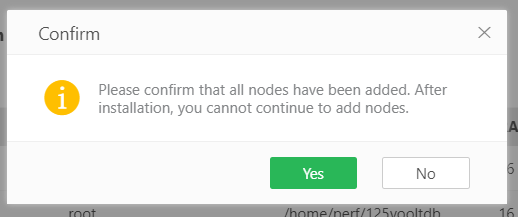|
<< Click to Display Table of Contents >> Deploy VooltDB |
  
|
|
<< Click to Display Table of Contents >> Deploy VooltDB |
  
|
When all the nodes are added and there is no problem, you can start to deploy VooltDB.
After deploying VooltDB, there are two solutions, stand-alone deployment and cluster deployment. If you choose to deploy VooltDB in a cluster, you need to configure all node information, and you need to configure Zookeeper cluster information. The Zookeeper information is filled in the Zookeeper cluster configuration on the node management page, as shown below Shown.
If it is a separately installed ZK cluster,You need to enter all Zookeeper cluster information in the text box. Each Zookeeper node is connected with ",". The format of each node is "IP:port" or "domain name:port".
If you use Yonghong integrated installation of zookeeper, you just need to click the get button to fill in automatically. For installation method, refer to zookeeper installation.

If you choose a stand-alone deployment, you only need to configure the VooltDB node information, and you don't need to configure the Zookeeper information. Keep the text box as default.
After the VooltDB node and Zookeeper cluster information is filled in, you can click the Install All button to install the node.

After clicking Install All, a prompt will pop up, and the operator needs to confirm that all nodes have been added.

If you click "Yes", the system will automatically install the VooltDB node. You can click the "Refresh" button to view the current installation status.
The node list will show the status of the current installation, as shown in the following figure, before the installation, the status of the node shows that it is not installed:

For nodes in the process of installation, the progress of node installation will be displayed:

After all the nodes are installed successfully, the installation will be displayed successfully:
